Standards Worldwide
Standards Worldwide
Phone +49 30 58885700-07

Standard [CURRENT]
ASTM F 1921/F 1921M:2012
Standard Test Methods for Hot Seal Strength (Hot Tack) of Thermoplastic Polymers and Blends Comprising the Sealing Surfaces of Flexible Webs
- Publication date
- 2012 reapproved: 2023
- Original language
- English
- Pages
- 9
- Publication date
- 2012 reapproved: 2023
- Original language
- English
- Pages
- 9
- DOI
- https://dx.doi.org/10.1520/F1921_F1921M-12R23
Product information on this site:
Quick delivery via download or delivery service
Buy securely with a credit card or pay upon receipt of invoice
All transactions are encrypted
Short description
1.1 These two test methods cover laboratory measurement of the strength of heatseals formed between thermoplastic surfaces of flexible webs, immediately after a seal has been made and before it cools to ambient temperature (hot tack strength). 1.2 These test methods are restricted to instrumented hot tack testing, requiring a testing machine that automatically heatseals a specimen and immediately determines strength of the hot seal at a precisely measured time after conclusion of the sealing cycle. An additional prerequisite is that the operator shall have no influence on the test after the sealing sequence has begun. These test methods do not cover non-instrumented manual procedures employing springs, levers, pulleys and weights, where test results can be influenced by operator technique. 1.3 Two variations of the instrumented hot tack test are described in these test methods, differing primarily in two respects: (a) rate of grip separation during testing of the sealed specimen, and (b) whether the testing machine generates the cooling curve of the material under test, or instead makes a measurement of the maximum force observed following a set delay time. Both test methods may be used to test all materials within the scope of these test methods and within the range and capacity of the machine employed. They are described in Section 4. 1.4 SI units are preferred and shall be used in referee decisions. Values stated herein in inch-pound units are to be regarded separately and may not be exact equivalents to SI units. Therefore, each system shall be used independently of the other. Combining values from the two systems may result in non-conformance with the standard. 1.5 This standard does not purport to address all of the safety concerns, if any, associated with its use. It is the responsibility of the user of this standard to establish appropriate safety and health practices and determine the applicability of regulatory limitations prior to use. The operator of the equipment is to be aware of pinch points as the seal jaws come together to make a seal, hot surfaces of the jaws, and sharp instruments used to cut specimens. It is recommended that the operator review safety precautions from the equipment supplier.
ICS
83.120
DOI
https://dx.doi.org/10.1520/F1921_F1921M-12R23
Loading recommended items...
Loading recommended items...
Loading recommended items...
Loading recommended items...
